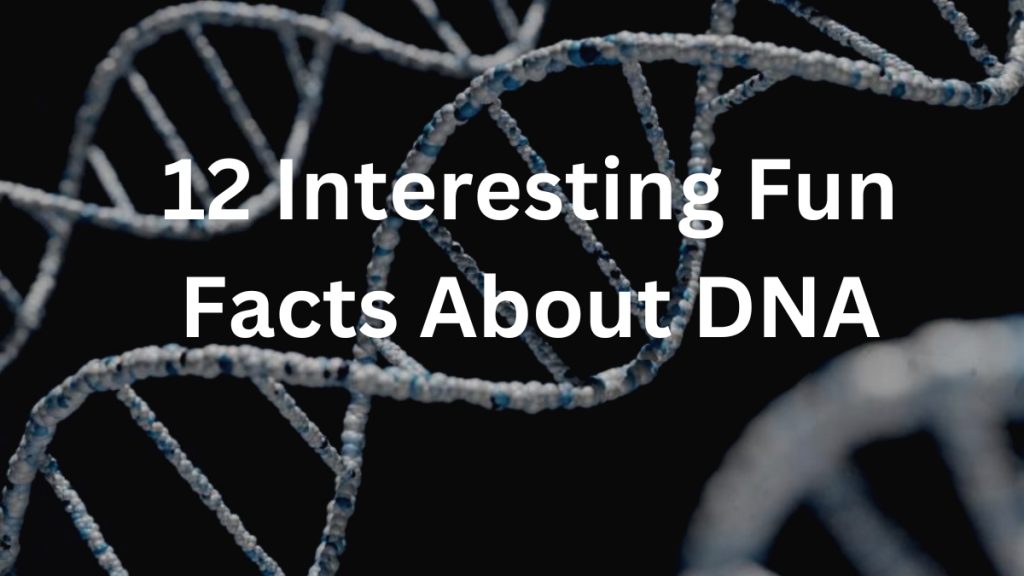DNA, short for deoxyribonucleic acid, is the genetic material that contains the instructions for the development and function of all living organisms. The discovery of DNA revolutionized the field of genetics and has since played a significant role in advancing various scientific fields. This blog post will explore 12 interesting, fun facts about DNA.
The discovery of DNA is attributed to Friedrich Miescher, a Swiss physician and biochemist. In 1869, he discovered a substance in the nucleus of cells, which he called “nuclein.” It was later renamed DNA.
2. DNA is Found in Every Living Organism
DNA is found in every living organism, including bacteria, plants, animals, and humans. The structure of DNA Testing is similar in all organisms, with only minor variations.
3. DNA is Shaped Like a Double Helix
Fun facts about DNA tells that it is made up of two long strands of nucleotides that are twisted together to form a double helix. The nucleotides comprise the deoxyribose, the phosphate group, and the nitrogenous base.
4. DNA Contains Four Nitrogenous Bases
Nucleotides are the building blocks of DNA. Adenine (A), guanine (G), cytosine (C), and thymine (T) are the four nitrogenous bases found in DNA (T). With A always partnering with T and C permanently coupling with G, these nitrogenous bases couple in a particular manner. The arrangement of these nitrogenous bases determines the genetic code of an organism. Understanding DNA’s structure, fun DNA facts and the function of nitrogenous bases has completely changed the study of genetics and opened the door to continued developments in biology and medicine.
5. Human DNA is 99.9% Identical a Great Fact about DNA
Despite the vast diversity of human beings according to interesting facts about DNA, their DNA is remarkably similar. Around 3 billion base pairs comprise the human genome, and everyone shares 99.9% of this DNA. The remaining 0.1% of the DNA sequence accounts for the genetic variations that make each person unique. These genetic variations are responsible for differences in physical traits, such as eye color, height, and disease susceptibility.
Don’t Ruin Your Relationship By Misunderstanding.
Get Accurate Answers With Our Paternity Test!
- Accredited Lab
- Accurate & Quick Results
- Private and Secure
- Affordable

6. DNA Contains Approximately 3 Billion Base Pairs
The human genome contains 3 billion BP is among facts about DNA, which are the building blocks of DNA. The human genome sequencing was completed in 2003 after 13 years of research.
7. DNA can be Extracted from Various Sources
DNA can be extracted from various sources, including DNA Clothing, blood, saliva, hair, and skin cells. DNA extraction is a crucial step in genetic research and forensic investigations.
8. DNA Replication is a Complex Process
DNA copies itself via a process called replication. It is a complex process involving several enzymes and proteins, and errors can lead to mutations and genetic disorders.
9. DNA can be Damaged by Radiation and Chemicals
DNA is a highly stable molecule, but it can be damaged by exposure to radiation and certain chemicals. Radiation can cause breaks in the sugar-phosphate backbone of DNA, leading to mutations or even cell death, a great fact about DNA. Chemicals such as certain pesticides and industrial pollutants can also cause damage to DNA by adding bulky groups to the nitrogenous bases, leading to mutations. DNA damage can have serious consequences, including cancer and other genetic disorders.
10. DNA can be Modified
DNA modification is a process by which chemical changes are made to the DNA sequence. This process plays a vital role in gene expression and is the basis of epigenetics, a field of study that explores how environmental factors can affect gene expression.
11. DNA is Used in Genetic Engineering
Genetic engineering involves modifying an organism’s DNA to achieve specific traits or characteristics. This technology has revolutionized agriculture and medicine, with genetically modified crops and gene therapies becoming increasingly common.
12. DNA Evidence is Commonly used in Forensic Investigations
DNA fact has become a game-changer in DNA Forensic Test investigations. The analysis of DNA samples found at crime scenes can identify suspects with a high degree of accuracy, sometimes even years after the crime has been committed. DNA evidence has been used to solve numerous high-profile cases and continues to be a crucial tool in the fight against corruption.
Conclusion
DNA is an incredible molecule that plays a vital role in the development of all living organisms. Its discovery has revolutionized various fields of science, including genetics, forensics, and medicine. These 12 fun facts about DNA only scratch the surface of what we know about this incredible molecule and its role in our lives.




















